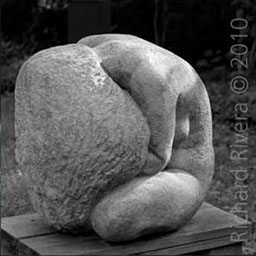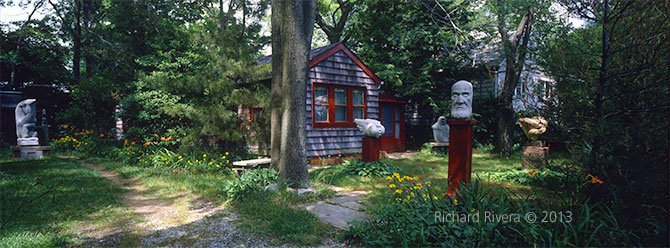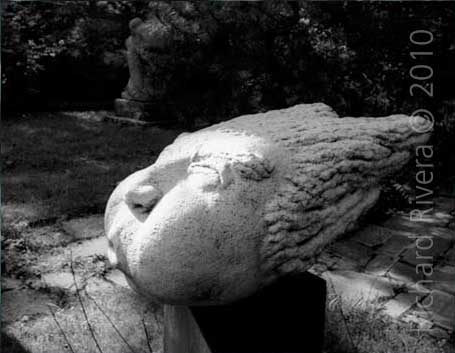
Creative Obsession
In 1988 I was asked to participate as a judge in an independent film competition
of works-in-progress conducted by the Brooklyn Arts & Cultural Association.
One of the films was a documentary, From Stone by Phil Katzman, about the New York sculptor Jacob Lipkin. It was the first time I had ever heard of Lipkin or seen his work. Viewing the film was the initial experience that inspired me to document Lipkin’s work photographically and write his biography, Creative Obsession: Reflections on the Life and Art of Jacob Lipkin.
Excerpt from the book—
“Jacob Lipkin stood like one of Melville’s weathered protagonists gazing into the darkness. The candlelight played across one side of his gray-bearded face, and he spoke softly of his life, his loves, of what made him pursue his art, and the sacrifices it had caused him. ‘The truth is: if I had a choice, I would not do it again …’ he said, ‘too painful.’ As the lights came up in the small cinema, I sat there overwhelmed by a multitude of feelings. I had watched a documentary on one man’s struggle to find his center point in life as a human being, and his triumph as an artist in the face of enormous odds. What would cause such a man to look back on such a distinctive, passionate, and prolific life and say, ‘I would not do it again’?”
Katzman’s documentary went on to win
several awards and aired on PBS television.
In that first glimmer of film I saw Lipkin
was a driven artist, one whose life had been
consumed by creative desire and the stresses
of financial survival. I empathized with him.
We had both grown up poor in the New York
City tenements, he in the 1910s and I forty
years later, but we had both struggled
financially to realize our creative goals.
In From Stone, Lipkin acknowledged that the
film will help his work attain the recognition
it deserves. He then said, “… now all we need is a book.” As an artist and fine art photographer, I always had an affinity for sculpture, both creating and photographing it. When I saw Lipkin’s work for the first time it sparked an admiration for his work and empathy for his dilemma. I left the film screening thinking to myself, why not a book? I had never attempted a book before and yet I knew it was the kind of project that would challenge me in a positive way.

Jacob Lipkin circa 1994



Top: Niobe, circa 1964 (31 in. high)
Middle: Whale, 1946. (16in. high)
Bottom: Polar Bear, 1967 (37 in.high)
Lipkin had created a powerful body
of work over his long career and yet continued to be relatively undiscovered as a sculptor representative of his period. Lipkin’s story and art became my “creative obsession.”
Katzman introduced me to Jacob and a couple of weeks later I traveled out to Long Island to meet him. Although Lipkin had grown up in the ghetto on the Lower East Side, over the years he had gradually moved out to Babylon, Long Island, where he had more space to carve large blocks of marble.
Making the trip from Penn Station in Manhattan to Babylon, Long Island, was a trek from the center of a metropolis to an almost provincial town. In the days when Lipkin first built his cottage that evolved into a home, Babylon was sparsely populated, heavily wooded, and had dirt roads. Arriving at his place for the first time was an even greater revelation than seeing his sculpture in film. His house and front yard were surrounded by sculptures, large and small. The marble and alabaster sparkled in contrast to the overgrown foliage of his yard and sculpture garden. I realized Jacob’s work was poetry in stone. His selective treatment of surfaces, choice of stone, or the softening of features in his work, came from a poet’s sensibilities.
Your feedback and comments are appreciated. See Contact page for e-mails.
Camera Sense Archives
APRIL 2015
Book review
iPad software
Movie review
Underwater dual-use camera review
Photo commentary
Book review
PhotoTech commentary
The Interview, movie review
Photo enhancement or management
MAY 2015
Photo Tech commentary
Photo/Art commentary
Camera review
TV series review
JUNE 2015
JULY 2015
AUGUST 2015
SEPTEMBER 2015
OCTOBER 2015

The front yard of Jacob Lipkin’s home in North Babylon, Long Island, as it stood in 1994. His studio was usually open to the public, and he was often host to passersby who were intrigued by the sculptures that were clearly visible from the street. An atypical view on a Long Island street. The path on the left led to a sculpture garden at the rear.
For months during the summer of 1988, I spent many hours from morning until dusk observing and photographing his sculpture garden, studio, and home. As the days became weeks and our conversations became more personal I realized that Lipkin
was a complex man whose story must be told, and I would be the one to write his biography. I began recording our talks and eventually recorded over twenty hours of interviews. Those extensive interviews are quoted verbatim in the chapter where he tells his story of being the fifteenth child of sixteen in 1909, of neglect and child abuse, of sailing out of New York harbor on a three-masted wooden barkentine at 16 years of age, his worldwide travels, discovering his creative impulse, and his return to New York eleven years later to become a highly respected sculptor.
Lipkin exhibited his work widely from 1940 to 1979 alongside his friend Jose de Creeft, Chaim Gross, Louise Nevelson, David Smith, and William Zorach amongst others. His work epitomizes American sculpture in the decades of the 1940s and 50s.
Although Lipkin enjoyed a 30-year retrospective of his work in 1968 sponsored by the Provident National Bank in Philadelphia, and his sculptural work is held in collections of the Fogg Museum in Massachusetts, The Jewish Museum in New York, Howard University in Washington, DC; the Philadelphia Zoo, and stands in Penwalt Plaza in Philadelphia, Lipkin’s belief was that the only thing that would ensure the survival of his work was if the Township of Babylon accepted his studio, remaining sculptures, paintings and drawings, and home as a gift and converted them into a museum. He lobbied the township hard for years to make that happen, but alas, it was not to be.
I remained close to Jacob until his death from cancer in 1996, and have worked ever since to shed light on his under-appreciated sculptural legacy. To this end I created the Jacob Lipkin Online Museum, where viewers can become acquainted with his work.
I have completed Creative Obsession: Reflections on the Life and Art of Jacob Lipkin with over 200 photographs of Lipkin’s work, written his biography, and documented his fascinating story as an artist.

For more information, photographs, and details
on the book visit the
Jacob Lipkin Online Museum at
http://riveraartse.com/lipkin_main.html
or email me at rrivera@eaglesofnewyork.com
North Wind by Jacob Lipkin
1963 (34 in. wide).
July 7, 2015
Copyright © 2015 Richard Rivera & Rivera Arts Enterprises All rights reserved. No copying or reproduction of any kind without express written permission from Richard Rivera
Legal Disclosure Camera Sense and Eagles of New York are trademarks of Elk Partners LLC